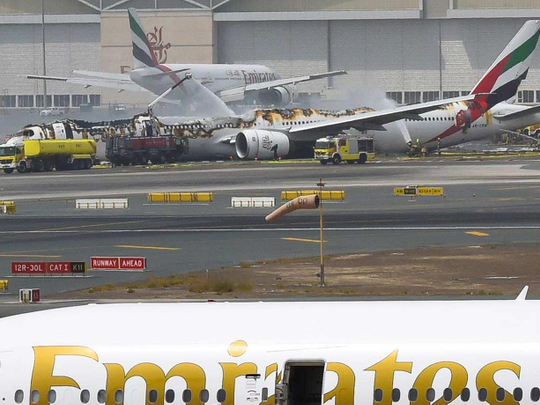
DUBAI: An Emirates flight from India carry 300 people caught fire shortly after landing at Dubai International on Wednesday, in what is the airliner’s first hull loss in its 31-year history.
There were no fatalities on board with the 282 passengers and 18 crew members safely evacuating the aircraft before flames destroyed the Boeing 777-300 aircraft, Emirates said. A firefighter lost his life battling the fire, United Arab Emirates’ federal aviation authority, the GCAA, said in a statement.
Flight EK521 from the southern Indian city of Thiruvananthapuram was involved in what Emirates described as an “accident” at 12:45pm, according to a post on the airliner’s Facebook page.
Video footage that has been widely circulated on social media shows an Emirates aircraft sliding down the airport’s runway on its belly with the right engine detached. Videos show thick black smoke billowing out from the aircraft into the air before catching fire. Gulf News was not able to independently verify the footage. Photographs later showed the aircraft’s roof completely burnt out.
The pilots, who each had over seven thousand hours of flying experience, may have aborted their initial landing attempt after experiencing a sudden change in wind direction, or wind shear, Emirates airline and group chairman and chief executive Shaikh Ahmad Bin Saeed Al Maktoum said at a press conference in Dubai late on Wednesday. He ruled out the possibility of a “security gap” in India and said that the Boeing 777, powered by Rolls-Royce Trent 800 engines, underwent its last maintenance check roughly a year ago.
“It was very much clear to land that day,” he said.
The GCAA said flight EK521 “made an emergency landing” at Dubai International. A flight EK521 passenger told Gulf News there was no announcement or indication that anything was wrong with the flight.
The plane touched down “as routine,” Indian national G. Jagadeesh told Gulf News, but then there was “shaking and then a big bump” and “we dropped suddenly.” The passengers were taken to a nearby hangar after escaping the aircraft using its inflatable emergency slides.
The fire destroyed the Boeing 777 aircraft that was delivered to Emirates in March 2003, according to flight tracker website flightradar24. It is the worst ever incident and first hull loss in Emirates’ three-decade history since starting operations in 1985. Emirates, the world’s biggest airline on international routes, is the largest operator of the Boeing wide-body jet and of the superjumbo Airbus A380.
“Emirates is fully cooperating with the authorities to determine the cause of incident,” Shaikh Ahmad said.
The GCCA said in a statement that it had mobilised an investigation team to assist Emirates and the authorities at the airport.
“Our investigators are working closely with Emirates Airlines and Dubai Airport to establish the cause of this accident,” the GCAA said in a separate statement.
US plane maker Boeing told Gulf News in an emailed statement that it was aware of the incident and said that it had a technical team on standby to support the US National Transportation Safety Board (NTSB). It is standard practice for the NTSB to be involved in investigations following an incident involving Boeing aircraft. The 777 is widely accepted as one of the safest aircrafts ever made, with very few having been involved in incidents where the aircraft was damaged beyond repair.
The passengers on board were from 20 countries, according to Emirates, including 226 passengers from India, 24 UK, 11 UAE, 6 US, 6 Saudi Arabia, 5 Turkey, 4 Ireland, 2 each from Australia, Brazil, Germany, Malaysia, Thailand and 1 each from Croatia, Egypt, Bosnia & Herzegovina, Lebanon, Philippines, South Africa, Switzerland and Tunisia. Emirates had earlier said there 275 passengers on board before later updating the number to 282.
Dubai International, the world’s busiest airport for international passengers, closed for around two and half hours following the incident and reopened at 6:30pm. Flights operated by larger aircraft were to be prioritised, operator Dubai Airports said.
Incoming flights to Dubai diverted to nearby Al Maktoum International at Dubai World Central (DWC) and Sharjah International Airport, along with other airports.
Emirates cancelled more than 40 flights across its network on Wednesday mainly affecting services to Middle East cities but also as to as far as Hong Kong and Geneva. The airline said it was expecting an 8-hour delay across it network. Emirates said it would waive rebooking, reissue and cancellation charges to passengers who have purchased their tickets on or before August 3. Meanwhile, flydubai, the second biggest operator at Dubai International after Emirates, cancelled all of its flights to and from the airport up until 10pm on Wednesday.
Earlier in in a video message, Shaikh Ahmad asked for the privacy of passengers and crew to be respected.
“Our priority right now is the safety of our passengers and crew and communicating with their families,” he said in the message posted on the twitter accounts of Emirates and the Dubai Media Office.
- with inputs from Fasial Masudi, Staff Reporter












